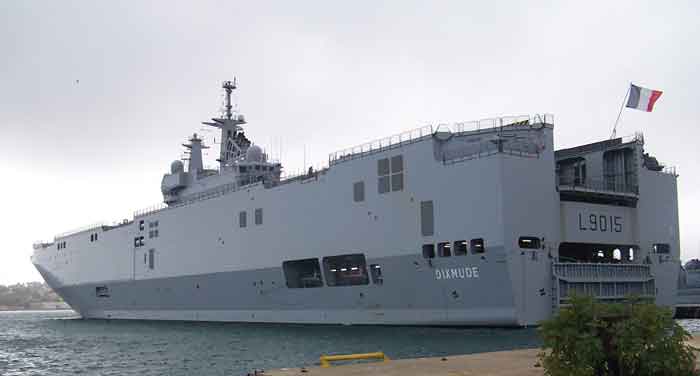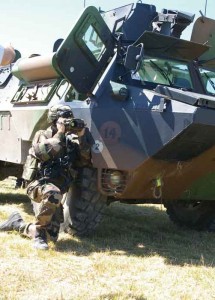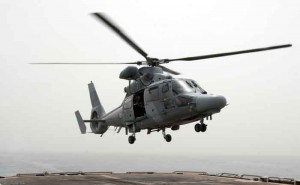
The Dixmude is the latest addition to the French Navy’s ‘Mistral’ class of amphibious support ship. The ‘Mistral’ class will also equip Russia performing a much needed modernization of that country’s naval amphibious fleet.
The French military aviation sector faces similar challenges as its counterparts producing equipment for land forces. Dassault Aviation is contemplating the future for its development of military aircraft beyond the Rafale-F3B/C/M jet which it is currently providing for the Armée de l’Air (AdlA/French Air Force) and Aeronavale (French Naval Aviation) and which has been selected as the preferred bidder for India’s Multi-Role Combat Aircraft programme. The company is currently leading the pan-European nEUROn Unmanned Combat Aerial Vehicle (UCAV) technology demonstrator programme. This is being pursued to prove and de-risk technologies which could be utilised onboard a future production UCAV built either exclusively by Dassault Aviation, or as a collaborative programme involving other European countries. France, meanwhile, is collaborating with the United Kingdom and Germany to develop a Medium Altitude Long Endurance Unmanned Aerial Vehicle.
The French state enjoys a controlling interest in many of the country’s leading defence material providers…
The development of new military aviation programmes will be important for Dassault Aviation. Presently, the company builds eleven Rafales per year for its French customer. Beyond the Rafale, the company has no military aircraft in its catalogue bar the platforms which it markets for maritime patrol based upon its Falcon Business Jet family. Over the next three years, the French government’s contribution to Dassault’s annual turnover is expected to reduce from 20 to 10 per cent as Rafale production begins to slow down.
Other aircraft programmes, which are yielding new platforms in the short term, are playing their important roles in keeping French defence contractors busy. Alongside the Dassault Rafale, the AdlA is the lead customer for the Airbus Military A400M Atlas strategic turboprop airlifter of which it will begin to receive from 2013. Although largely constructed in Seville, southern Spain, several French companies such as Thales and Sagem are significant sub-contractors on the programme. The same is also true for the Airbus A330 Multi-Role Tanker Transport (MRTT) which the AdlA will receive in the future, although the construction of this aircraft is expected to occur in France at Airbus’s large manufacturing complex in Toulouse where the Airbus A330 family of airliners is constructed. Up to 14 A330MRTT aircraft are expected to eventually be procured by the AdlA.
Collaboration is forthcoming between France and the UK in the missile domain. Both nations are moving forward with the development of a new helicopter-launched anti-shipping missile in the guise of the Future Air-Surface Guided Weapon-Heavy (FASGW-Heavy) which is expected to be ready for use by the Royal Navy and the Marine Nationale (French Navy) after 2015. The FASGW programme is divided into a number of distinct work strands with the anti-ship missile falling into the Heavy category, and the Thales Lightweight Multirole Missile (LMM), which is being developed bilaterally between the two countries as a helicopter-launched missile, fulfilling the FASGW-Light commitment. The first LMM examples are expected to commence delivery in 2013.

The French Navy is taking delivery of several thousand FELIN infantry soldier modernisation systems. Sagem, FELIN’s manufacturer, is working hard to export FELIN to Switzerland.
French naval shipbuilding is dominated by DCNS which is currently engaged in an overarching effort to improve the efficiency of the firm. Under the direction of its Chief Executive Patrick Boissier, DCNS is seeking to achieve performance improvements of up to 30 per cent. This is in addition to an initiative launched in 2009 to double the value of the firm’s exports from around €2.5 billion ($3.2 billion) by 2020. The increase in exports is seen as being important for the company in lieu of the expected reductions in domestic orders vis-à-vis the widely-anticipated cuts to the French defence budget. Currently, the company is leading three important domestic programmes the Franco-Italian ‘Horizon’ class air defence destroyer, the ‘Acquitaine’ class FREMM (Fregate Multi-Mission) multi-purpose frigate and ‘Barracuda’ class nuclear-powered attack submarine. DCNS has scored some important export successes, notably winning orders for the ‘Mistral’ class amphibious support ship which it constructs in collaboration with the South Korean shipbuilder STX, and the FREMM frigate which it has exported to Morocco.
DCNS is seeking to enlarge its presence in the international naval market via its ‘Gowind’ class Offshore Patrol Vessel (OPV) and corvette design. The ‘Gowind’ is essentially a scalable ship configuration which can be enlarged or reduced in size according to the needs of the customer. Gowind sales have already been forthcoming to Malaysia. Away from Malaysia, DCNS is looking at selling additional conventional submarines to India beyond the six ‘Scorpene’ class conventional boats which our country has already acquired. Over the longer term, DCNS is plans to increase its presence in North America proposing designs for an ambitious national shipbuilding programme which will overhaul the Royal Canadian Navy’s surface ship fleet, and partnering with local companies in the United States of America in a bid to satisfy a requirement for a new class of large ocean-going cutters to equip that country’s Coast Guard.
International cooperation has been problematic and the industry is eagerly anticipating new domestic procurement programmes…
For the home market, the French Navy is enthusiastically lobbying for a new class of OPV to equip the fleet. The navy says that these ships will play a valuable role in patrolling France’s Exclusive Economic Zones (EEZ). The country has the world’s second biggest combined EEZ after the US. Should the go-ahead be given for the construction of a new series of OPVs, it would replace circa 20 disparate ships currently in use by the Marine Nationale for the offshore patrol mission. Ideally, the navy says, these new ships would enter service in circa 2017.
In the short term, the navy has secured funding worth €554 million ($725 million) to procure eight offshore multi-mission boats which will be used for this role and are scheduled to enter service with the navy in 2015. Construction of these vessels is being funded in an innovative fashion; the defence ministry is picking up the bill for 80 per cent of their construction, with other government ministries absorbing the balance of the cost.
DNCS yards will be kept busy building the six Barracuda boats that the navy is to receive plus the eleven FREMM frigates equipping the force. Given the political impetus on François Hollande to reduce the French budget defence through cuts to public spending, including the defence budget, it remains to be seen whether the navy will acquire additional OPVs beyond the eight multi-mission ships already earmarked for construction.

The French Navy operate a number of legacy aircraft types such as the Eurocopter AS-565 Panther. This aircraft will eventually be replaced in service by the NH Industries NH90 NATO Frigate Helicopter
The French Navy is still planning to replace its existing four ‘Meuse’ class underway replenishment ships and its single ‘Jules Verne’ auxiliary vessel (which was retired in 2009) with a new four-vessel series of logistics platforms from 2015. DCNS and STX France have proposed their ‘Brave’ class design to fulfill this requirement.
Exports
Although French defence contractors will have to chase international sales with increased vigour because of expected budget reductions, they will be doing so from an advantageous position. France continues to be a major exporter of materiel, exporting €6.4 billion ($8.4 billion) worth of defence equipment in 2011; a 27 per cent increase on the value of defence exports in 2010, making the country the worlds’ fourth biggest exporter. Around 42 per cent of these exports were made to customers in the Asia-Pacific region with French defence companies enjoying an increasingly healthy order book thanks to sales to Middle Eastern customers, most notably Saudi Arabia and the United Arab Emirates.
Exports of defence materiel are likely to play an increasingly important role for French manufacturers as the domestic market for military equipment contracts in line with expected cuts in the national defence budget.
DCNS is seeking to enlarge its presence in the international naval market via its ‘Gowind’ class Offshore Patrol Vessel (OPV)…
Livre Blanc
Several aspects regarding the long-term future of the French defence industrial base remain unknown, and are unlikely to become evident until the government publishes its anticipated Livre Blanc (White Paper) on defence in February 2013. This document is expected to outline the strategic and defence spending priorities of the government between 2014 and 2019.
Few in the French government or the French polity at large are under any illusion that Mr. Hollande will have to make some drastic cuts in the coming years to French public spending if the economy is to remain buoyant. The President has promised to cut the budget deficit by three per cent next year. Defence spending in France has in recent years been largely ring-fenced from the reductions which have been witnessed in other areas of the French state, most notably in education.
Several members of Mr. Hollande’s Socialist Party and his supporters in France may feel that it is time for defence to take its share of the burden particularly if this helps to insulate other government services such as health and education provision from further budgetary reductions. Moreover, with France now having concluded combat missions in Afghanistan and the troops on their way home, save for a contingent which will continue mentoring the Afghan army and security forces, it may be more difficult for the President to argue that defence spending needs to be shielded from cutbacks.
Although no firm figure has been set regarding planned reductions to the country’s defence budget, it is currently valued at around two per cent of Gross Domestic Product (GDP), although the Foreign Affairs and Defence Committee of the Senate, France’s Upper House of Parliament, has urged that it not be reduced below 1.5 per cent of GDP. With anticipated reductions in defence spending clearly on the way, the impetus for France’s defence companies to seek out and enjoy success in the international defence market will become all the more urgent.




